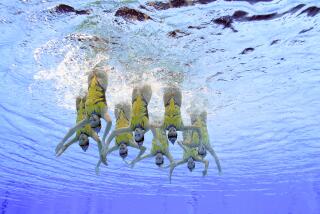Off of Virginia, an annual pony swim
Reporting from Chincoteague, Va. — “‘Course it’s a legend. But legends be the only stories as is true.”
Grandpa, in “Misty of Chincoteague,” by Marguerite Henry
As he motors his pontoon boat away from the dock and into one of the shallow channels that surround Chincoteague Island, tour guide Ray Davis urges his guests, a Mennonite family from Pennsylvania, not to accept his every word as gospel.
“A third of what I’m gonna tell you is definitely true,” he says in a southern Virginia drawl. “Another third might be true. And the final third is just plain made up.”
Indeed, on Chincoteague and Assateague islands, it’s often difficult to distinguish fact from fable, as Grandpa noted in the 1947 children’s classic. The slender fingers that protect the mainland from the ocean’s impulses provide many a legend, most of them surrounding the enchanting wild ponies that are the islands’ biggest visitor attraction.
Each year in late July, hordes of tourists grab every available motel room and campsite to catch a glimpse of dozens of ponies swimming the channel from Assateague to Chincoteague, where they’re penned and, the next day, sold at auction to raise money for the local volunteer fire company.
The tradition began in 1925, but it wasn’t until publication of “Misty of Chincoteague” that word of the unique pony swim really began to reach folks far and wide.
Along with the main characters, siblings Paul and Maureen Beebe, the book’s namesake was real. Author Marguerite Henry first laid eyes on Misty during the 1946 roundup and wrote her award-winning book while staying at Miss Molly’s, a local boarding house.
“She kind of named herself,” Paul answered. “When I was in the woods there on Assateague, I couldn’t tell if I was seeing white mist with the sun on it, or a live colt. The minute I knew ‘twas a live colt, I kept calling her Misty in my mind.”
Just as young Paul did, you can still see the ponies roaming wild on these barrier islands. They’re often spotted from Ray Davis’ boat.
Davis dispels the notion that a “pony” is simply a young horse. In fact, it’s any horse that stands less than 14 1/2 hands — that’s 58 inches — at the shoulders.
“Chincoteague ponies are about 12 to 12 1/2 hands,” he explains.
The lifelong resident of Chincoteague — neighboring Assateague is uninhabited, at least by humans — tells visitors that no one’s sure exactly how the majestic animals ended up here. One of the legends creates a fantastic yet plausible tale.
In 1750, the Spanish warship La Galga ran aground and broke up in stormy seas off Assateague Island.
Most of the soldiers aboard swam safely to shore, and with them — at least according to one narrative — came their horses.
“The speculation is that the horses were Spanish Barbs,” Davis says of the breed known to have been used by the soldiers. He says that the first recorded sighting of horses on the island came the following year.
Hundreds of the ponies still roam unfettered on the island. While the annual pony swim is quite the spectacle — replete with carnival rides and stands selling oyster sandwiches and crab cakes — the crowds and the queues may be good incentives to visit at a quieter time.
Only a part of the ponies are sold at the auction on Chincoteague. The rest are coaxed back into the water for the return swim to Assateague, where they forage in the woods and along the shore, often just a few yards from two-legged day trippers who have come to photograph the still-working lighthouse or to catch some rays on a pristine beach.
A visitor center is a popular first stop after crossing the short bridge linking the two islands. Displays explain Assateague’s varied flora and fauna, including the ever-popular ponies. An exhibit about them favors a different legend as to how the horses got here, suggesting that early settlers from the mainland brought their beasts to the island in the 1600s to hide them from tax collectors.
After a bit of banter, some volunteers at the center may share with guests where ponies recently have been spotted. Just a few hundred yards from a popular stretch of beach, the wild critters sometimes are found grazing and lazing in the salt grass of Tom’s Cove.
“Misty seemed to sense the importance of this moment. … Her whole body quivered as if she saw a promise of great things to come — of races won, of foals tagging at her side.”
Several decades have passed since Misty’s mane flapped in the ocean breeze, yet she still stands tall. After her death, she was preserved by a taxidermist. All 12 hands of her are now proudly displayed inside a small museum on the Beebe family ranch. Just a whinny away, her progeny still frolic, their lungs inhaling the fresh, salt air.
More to Read
Sign up for The Wild
We’ll help you find the best places to hike, bike and run, as well as the perfect silent spots for meditation and yoga.
You may occasionally receive promotional content from the Los Angeles Times.




